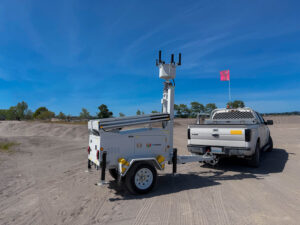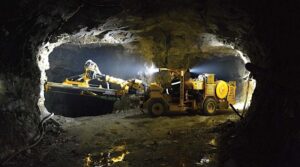
Open-pit mining is one of the most demanding industries, requiring large-scale operations, heavy machinery, and a highly organized network of communication to ensure safety and efficiency. Wireless communication, tracking, and automation systems have become essential to modern mining operations, and antennas play a central role in these technologies. They support real-time data transfer, vehicle tracking, and process automation, providing the communication backbone that makes open-pit mining operations safer and more productive. This post explores how antennas are used in open-pit mining, with a look at specific applications, challenges, and the importance of reliable signal transmission.

In open-pit mining, communication networks are essential for the coordination of vehicles, the monitoring of heavy machinery, and the tracking of personnel. Given the vast, often remote locations where open-pit mines are situated, antennas play a critical role in creating a robust communication infrastructure. Antennas serve as the physical link between different devices and systems, enabling a constant flow of data that keeps operations running smoothly.
There are typically three types of networks at work in these environments: local area networks (LANs) for close-range communications, wide area networks (WANs) for connecting across the entire mining site, and low-power, wide-area networks (LPWANs) for specific applications, such as remote equipment monitoring. The antennas deployed in open-pit mining are often designed to withstand harsh conditions, such as extreme weather, heavy dust, and vibration from heavy equipment, ensuring reliable performance and connectivity.
Antennas in open-pit mining serve multiple functions, enabling seamless wireless communication, real-time tracking, and advanced automation. Here are some specific use cases:
Heavy machinery, like haul trucks and excavators, is continuously moving across the mining site. Using GPS and RFID-enabled tracking systems, antennas help monitor the real-time location of each piece of equipment, allowing operators to know precisely where every vehicle is at any time. This real-time tracking is crucial for optimizing equipment allocation, improving route efficiency, and preventing accidents by alerting operators to nearby vehicles or potential hazards.
Worker safety is paramount in mining, and antennas support personnel tracking systems that help keep workers safe. By equipping employees with wearable devices or using smart helmets, antennas transmit workers’ locations, monitor environmental conditions, and provide immediate alerts in emergencies. In the event of a rockfall, landslide, or other accident, antennas allow emergency responders to locate affected personnel quickly, improving rescue response times.
Antennas facilitate data transfer from sensors installed on mining equipment, providing insights into the operational health of machinery. Through wireless communication, these sensors send data back to a central control system, where operators can monitor metrics like engine temperature, oil pressure, and fuel levels. This remote monitoring enables predictive maintenance, allowing mining companies to address potential issues before they lead to equipment breakdowns, thus minimizing downtime and maximizing productivity.
Many modern open-pit mines utilize autonomous vehicles for haulage and drilling tasks. Antennas enable these autonomous systems to receive instructions, communicate their status, and navigate effectively across the site. This automation reduces the need for human drivers in hazardous areas and improves operational efficiency by ensuring that tasks are carried out with precision and consistency. The use of antennas to support vehicle-to-vehicle (V2V) and vehicle-to-infrastructure (V2I) communication is vital for coordinating autonomous fleet movements, minimizing collisions, and optimizing routing.
Antennas also play a role in environmental monitoring, which is crucial for compliance with regulatory standards and minimizing environmental impact. Sensors deployed across a mine site can measure parameters such as air quality, water levels, and soil composition. Antennas then relay this data back to central systems, enabling operators to take timely actions to reduce dust, prevent water contamination, and manage waste, thereby making mining operations more sustainable.
Mining environments present unique challenges to signal transmission, including vast open spaces, rugged terrain, and constant movement of large vehicles and equipment. Reliable signal transmission is crucial because any lapse in communication can lead to operational disruptions, safety hazards, or equipment damage. Antennas used in open-pit mining must be designed to handle these challenges by ensuring strong, stable signals that maintain connectivity even under challenging conditions.
To ensure dependable communication, mining operations often deploy a mix of high-gain, directional, and omnidirectional antennas, creating a network architecture that can adapt to site-specific needs. High-gain antennas, for instance, focus energy in a specific direction, making them ideal for long-distance communication between different areas of the mine. Omnidirectional antennas, on the other hand, provide 360-degree coverage and are useful for tracking and close-range communications within the site.
Redundant communication systems are also essential in these environments. Should one network experience a failure, secondary networks take over, ensuring no critical data is lost, and operations continue without interruption. Additionally, mesh networks, where each antenna acts as a relay point, can enhance network resilience by creating multiple communication paths, reducing the risk of total network failures.
 The role of antennas in open-pit mining is indispensable, serving as the backbone of modern communication, tracking, and automation systems. By enabling real-time equipment tracking, supporting worker safety, and facilitating predictive maintenance, antennas contribute to the efficiency and safety of mining operations. In environments where reliable communication can make the difference between smooth operations and costly downtime, choosing the right antennas and network configurations is critical. As mining technology continues to advance, the demand for robust, high-performance antennas will only grow, making them a cornerstone of sustainable, efficient, and safe mining practices.
The role of antennas in open-pit mining is indispensable, serving as the backbone of modern communication, tracking, and automation systems. By enabling real-time equipment tracking, supporting worker safety, and facilitating predictive maintenance, antennas contribute to the efficiency and safety of mining operations. In environments where reliable communication can make the difference between smooth operations and costly downtime, choosing the right antennas and network configurations is critical. As mining technology continues to advance, the demand for robust, high-performance antennas will only grow, making them a cornerstone of sustainable, efficient, and safe mining practices.


